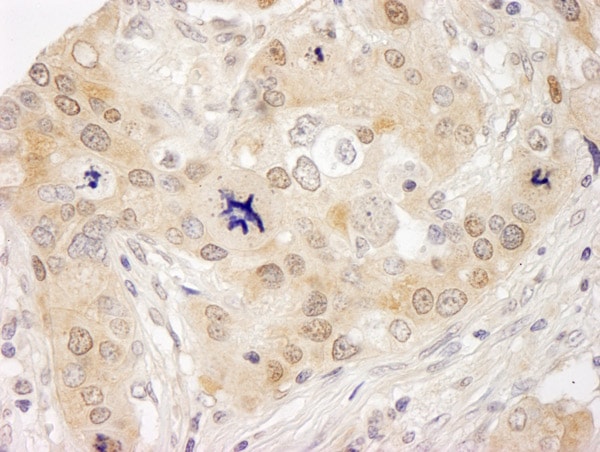Anti-HUWE1/Mule antibody (ab70161)
Key features and details
- Rabbit polyclonal to HUWE1/Mule
- Suitable for: ICC/IF, WB, IHC-P
- Reacts with: Human
- Isotype: IgG
Overview
-
Product name
Anti-HUWE1/Mule antibody
See all HUWE1/Mule primary antibodies -
Description
Rabbit polyclonal to HUWE1/Mule -
Host species
Rabbit -
Tested applications
Suitable for: ICC/IF, WB, IHC-Pmore details -
Species reactivity
Reacts with: Human
Predicted to work with: Chimpanzee, Gorilla, Orangutan
-
Immunogen
Synthetic peptide corresponding to Human HUWE1/Mule aa 2250-2300.
Database link: Q7Z6Z7 -
General notes
This product was previously labelled as HUWE1
Reproducibility is key to advancing scientific discovery and accelerating scientists’ next breakthrough.
Abcam is leading the way with our range of recombinant antibodies, knockout-validated antibodies and knockout cell lines, all of which support improved reproducibility.
We are also planning to innovate the way in which we present recommended applications and species on our product datasheets, so that only applications & species that have been tested in our own labs, our suppliers or by selected trusted collaborators are covered by our Abpromise™ guarantee.
In preparation for this, we have started to update the applications & species that this product is Abpromise guaranteed for.
We are also updating the applications & species that this product has been “predicted to work with,” however this information is not covered by our Abpromise guarantee.
Applications & species from publications and Abreviews that have not been tested in our own labs or in those of our suppliers are not covered by the Abpromise guarantee.
Please check that this product meets your needs before purchasing. If you have any questions, special requirements or concerns, please send us an inquiry and/or contact our Support team ahead of purchase. Recommended alternatives for this product can be found below, as well as customer reviews and Q&As.
Properties
-
Form
Liquid -
Storage instructions
Shipped at 4°C. Upon delivery aliquot and store at -20°C. Avoid freeze / thaw cycles. -
Storage buffer
pH: 7
Preservative: 0.09% Sodium azide
Constituents: 1.815% Tris, 1.764% Sodium citrate, 0.021% PBS -
 Concentration information loading...
Concentration information loading... -
Purity
Immunogen affinity purified -
Clonality
Polyclonal -
Isotype
IgG -
Research areas
Images
-
All lanes : Anti-HUWE1/Mule antibody (ab70161) at 1 µg/ml
Lane 1 : 293T whole cell lysate at 50 µg
Lane 2 : 293T whole cell lysate at 15 µg
Lane 3 : 293T whole cell lysate at 5 µg
Predicted band size: 481 kDa
Observed band size: >460 kDa why is the actual band size different from the predicted?
Additional bands at: 200 kDa, 300 kDa. We are unsure as to the identity of these extra bands.
-
 Immunohistochemistry (Formalin/PFA-fixed paraffin-embedded sections) - Anti-HUWE1/Mule antibody (ab70161)
Immunohistochemistry (Formalin/PFA-fixed paraffin-embedded sections) - Anti-HUWE1/Mule antibody (ab70161)Immunohistochemistry (Formalin/PFA-fixed paraffin-embedded sections) analysis of human ovarian carcinoma tissue labelling HUWE1/Mule with ab70161 at 1/1000 (1µg/ml). Detection: DAB.
-
ICC/IF image of ab70161 stained HepG2 cells. The cells were 4% formaldehyde fixed (10 min) and then incubated in 1%BSA / 10% normal goat serum / 0.3M glycine in 0.1% PBS-Tween for 1h to permeabilise the cells and block non-specific protein-protein interactions. The cells were then incubated with the antibody (ab70161, 1µg/ml) overnight at +4°C. The secondary antibody (green) was Alexa Fluor® 488 goat anti-rabbit IgG (H+L) used at a 1/1000 dilution for 1h. Alexa Fluor® 594 WGA was used to label plasma membranes (red) at a 1/200 dilution for 1h. DAPI was used to stain the cell nuclei (blue) at a concentration of 1.43µM.
-
 Immunohistochemistry (Formalin/PFA-fixed paraffin-embedded sections) - Anti-HUWE1/Mule antibody (ab70161)IHC image of ab70161 staining in human normal heart formalin fixed paraffin embedded tissue section, performed on a Leica BondTM system using the standard protocol F. The section was pre-treated using heat mediated antigen retrieval with EDTA (pH9, epitope retrieval solution 2) for 20 mins. The section was then incubated with ab70161, 5µg/ml, for 15 mins at room temperature and detected using an HRP conjugated compact polymer system. DAB was used as the chromogen. The section was then counterstained with haematoxylin and mounted with DPX.
Immunohistochemistry (Formalin/PFA-fixed paraffin-embedded sections) - Anti-HUWE1/Mule antibody (ab70161)IHC image of ab70161 staining in human normal heart formalin fixed paraffin embedded tissue section, performed on a Leica BondTM system using the standard protocol F. The section was pre-treated using heat mediated antigen retrieval with EDTA (pH9, epitope retrieval solution 2) for 20 mins. The section was then incubated with ab70161, 5µg/ml, for 15 mins at room temperature and detected using an HRP conjugated compact polymer system. DAB was used as the chromogen. The section was then counterstained with haematoxylin and mounted with DPX.
For other IHC staining systems (automated and non-automated) customers should optimize variable parameters such as antigen retrieval conditions, primary antibody concentration and antibody incubation times.













